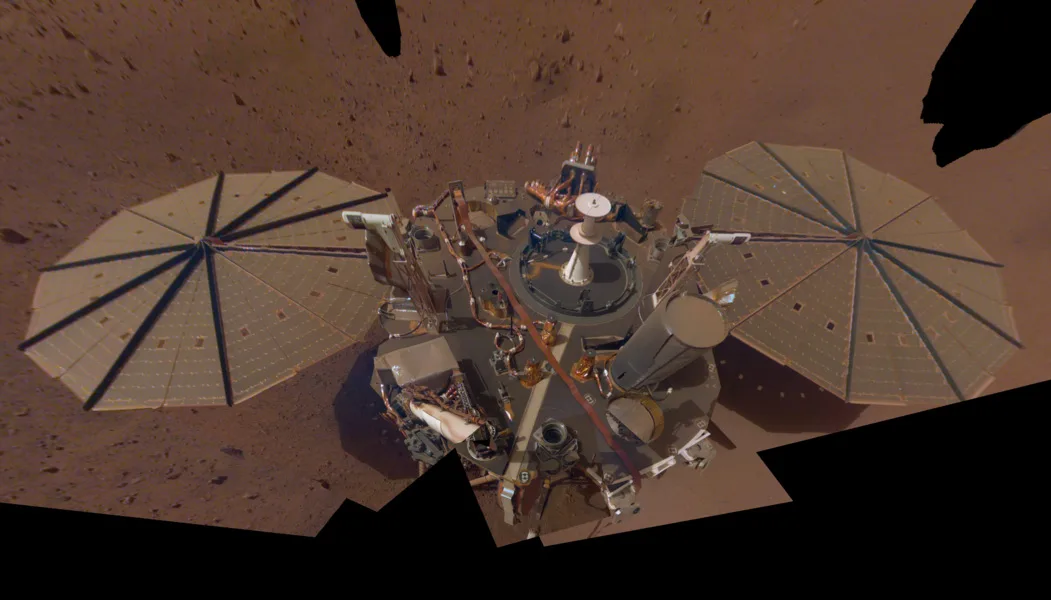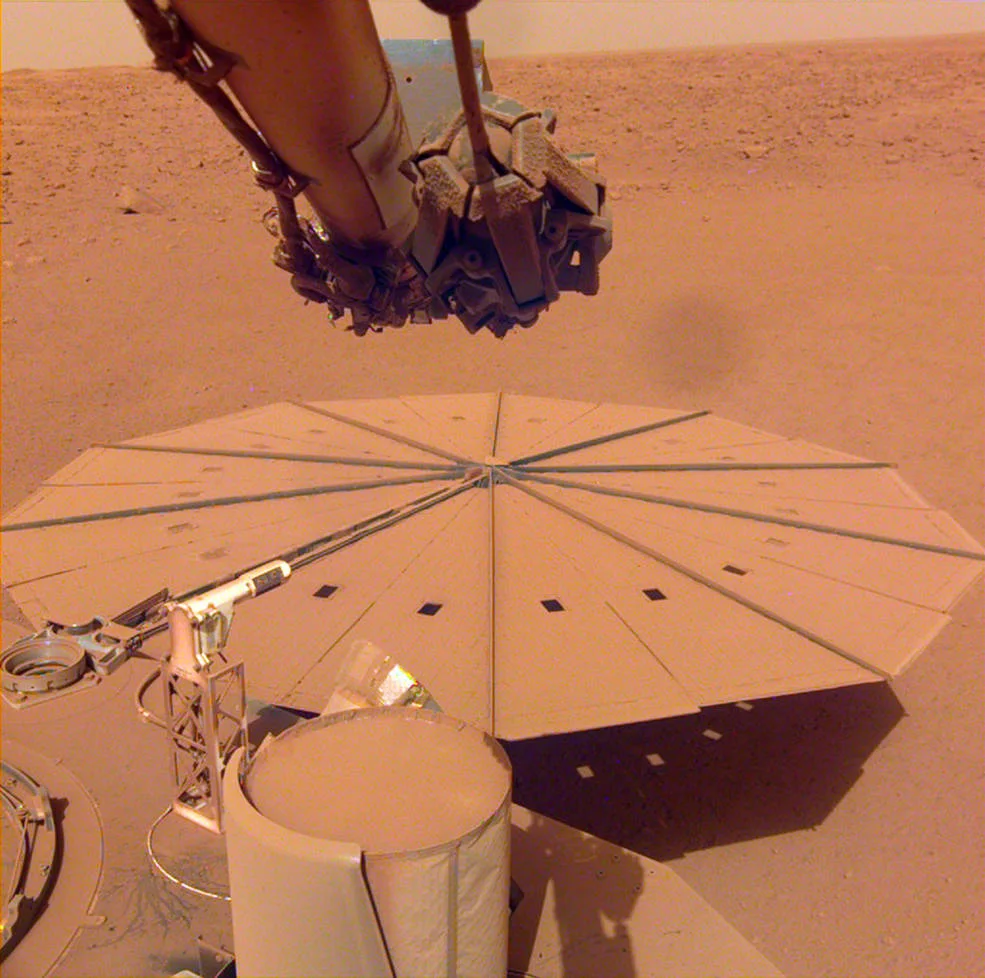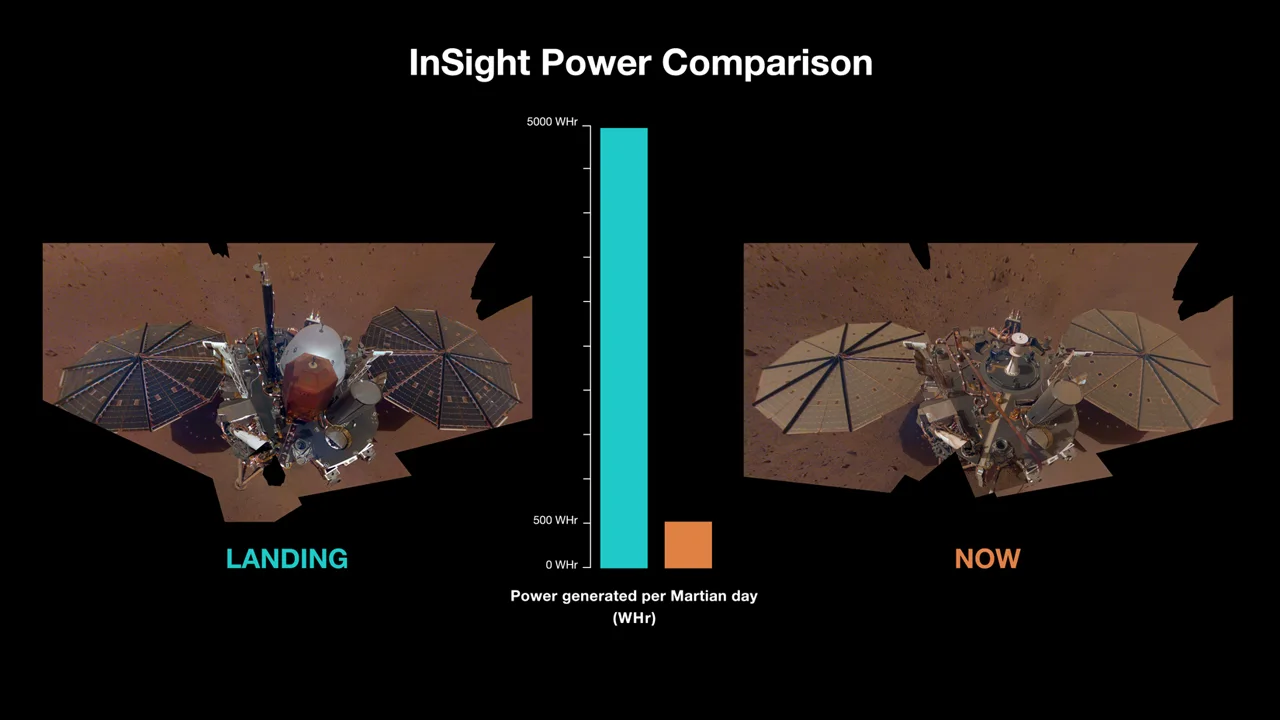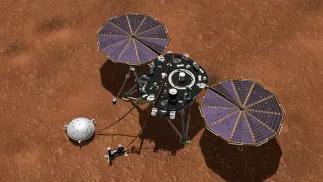
Without a lucky break from the weather, NASA will lose a Mars mission this year
As its power dwindles, NASA's InSight lander will soon end its hunt for marsquakes.
After three and a half years of hunting for marsquakes, it's looking as though the mission for NASA's Insight lander will soon end.
A few weeks ago, InSight detected its largest marsquake of the mission so far. However, it looks as though the lander caught that 'big one' just in time. Based on the dwindling power being supplied by its dusty solar panels, NASA now believes that InSight probably has until the end of this year before they are forced to shut it down for good.

This Instrument Deployment Camera image shows one of InSight's dust-covered solar panels sol 1,211 of the mission (April 24, 2022). Credits: NASA/JPL-Caltech
In a media teleconference on Tuesday, mission leaders outlined their plans to slowly decommission InSight in the months to come.
Sometime over the next month, the team will perform a few more actions with the lander's arm, and then it will be set into what they call its retirement pose. They will angle the arm so that the Instrument Deployment Camera (IDC) is pointed down at the deck, and then they will leave the arm in that position.
They expect to end all science operations by late summer, including shutting down the seismometer, instruments that measure ground heat and the planet's wobble, and the lander's weather station. Then, by the end of the year, the mission should officially come to an end.

Due to the dust accumulated on InSight's solar panels the lander is now only getting around one-tenth of the power it was getting when it first landed. Credit: NASA/JPL-Caltech
TOO SOON!
Seeing a NASA Mars mission last for only four years may seem like a very short time. We've been 'spoiled' some, perhaps, by missions like Spirit and Opportunity, which kept roving for over 6 years and over 14 years, respectively. Plus, the Curiosity rover is coming up on its 10th landiversary on Mars in early August.
Unfortunately, while Spirit and Opportunity had some lucky breaks during their explorations, in the form of dust devils clearing off their solar panels, InSight hasn't been as fortunate.
With power levels as low as they are now and the changing seasons set to loft more dust into the air, the mission's time is growing short.
According to NASA: "Over the next few months, there will be more dust in the air, reducing sunlight – and the lander's energy. While past efforts removed some dust, the mission would need a more powerful dust-cleaning event, such as a 'dust devil' (a passing whirlwind), to reverse the current trend."
"We've been hoping for a dust cleaning like we saw happen several times to the Spirit and Opportunity rovers," Bruce Banerdt, InSight's principal investigator at NASA's Jet Propulsion Laboratory, said in a press release. "That's still possible, but energy is low enough that our focus is making the most of the science we can still collect."
OUR FIRST LOOK INSIDE
NASA has been exploring Mars since the mid-1960s. Over the decades, orbiting satellites have extensively mapped the planet, and several missions — landers and rovers — have touched down to explore parts of the surface. One mystery that persisted over the years, though, is what the planet's interior looks like.
While planetary scientists had a reasonable idea of what the inside of Mars should look like, the first authentic 'look' at the planet's interior came just within the past three years.
That first 'look' was sent back by InSight (whose name is short for "Interior Exploration using Seismic Investigations, Geodesy and Heat Transport").

This artist's impression shows the InSight lander on the surface of Mars, after deploying its SEIS instrument (under the small white dome) and heat probe. Credit: NASA/JPL-Caltech
This lander touched down in Elysium Planitia back in November 2018. Shortly after that, it set an instrument down on the ground known as the Seismic Experiment for Interior Structure (SEIS). SEIS is an extremely sensitive seismometer designed to detect even the tiniest tremors passing through the Martian surface.
Thus began the search for marsquakes!

This view from InSight's Instrument Context Camera (ICC) shows an early shot from the mission, with SEIS (under the white dome) sitting on the ground in Elysium Planitia. Credit: NASA/JPL-Caltech
First, this was exciting because it showed that Mars is seismically active. On Earth, most earthquakes result from plate tectonics — the movement of large areas of the planet's crust — as the plates push and rub against each other. However, Mars doesn't have plate tectonics.
However, planetary scientists still believed that we'd see tremors. They would result from processes other than the movement of tectonic plates, such as from inside the planet or from meteorite impacts. Regardless of the source of the tremors, though, they would still provide us with the same vibrations that would reveal the planet's internal structure.
As they spotted more marsquakes, the data slowly built up a clear picture of the inside of Mars, giving the scientists a look at the size of the planet's core and the thickness of the other interior layers.

An artist's impression of Mars' interior (left) is compared to SEIS data (center), to show where the boundaries exist between the layers of the planet's interior (right). Credit: NASA/Deng & Levander, 2020/GRL/Scott Sutherland
So, although this mission's timeline is shorter than others, it has accomplished quite a bit in the time it has already had. Even by the end of 2020, InSight had effectively completed its primary mission. Everything since then, including the largest marsquake detected so far, has just been a bonus.
"InSight has transformed our understanding of the interiors of rocky planets and set the stage for future missions," Lori Glaze, director of NASA's Planetary Science Division, said in Tuesday's press release. "We can apply what we've learned about Mars' inner structure to Earth, the Moon, Venus, and even rocky planets in other solar systems."
